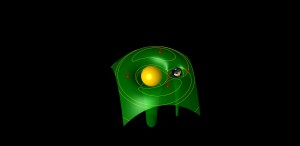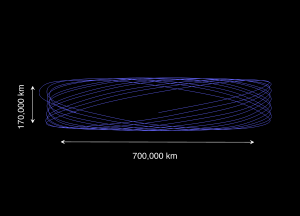 Just like observatories on Earth, space observatories like Gaia like it quiet and dark. In space “quiet and dark” means far away from Earth. At large distances from Earth, the motion of spacecraft are no longer controlled only by the gravity of Earth, but also by other gravitational sources – most prominently by the Sun. The orbital motion of Earth around the Sun also influences the motion of spacecraft.
Just like observatories on Earth, space observatories like Gaia like it quiet and dark. In space “quiet and dark” means far away from Earth. At large distances from Earth, the motion of spacecraft are no longer controlled only by the gravity of Earth, but also by other gravitational sources – most prominently by the Sun. The orbital motion of Earth around the Sun also influences the motion of spacecraft.
The good thing about these forces – if you are a spacecraft – is that in five locations, all these forces balance out to create a stable location from which to study the wider Universe.
These points are called the “Lagrange points”, or L-points. L1 is located between the Sun and Earth, 1.5 million kilometres from Earth, and L2 is on the opposite side of Earth at the same distance. L3 is behind the Sun 300 million kilometres away. L4 and L5 are leading and trailing the Earth respectively. If you imagine two equilateral triangles with the baseline joining up the Sun and Earth, then L4 and L5 make up the third point of each triangle either ‘ahead’ or ‘behind’ Earth along its orbit around the Sun.
Gaia, like many other spacecraft that have gone there before, will orbit around the L2 point. It is not stationary here, or else Earth would always be in front of the Sun as seen from the spacecraft – then Gaia would be in eclipse and there would be no power from the solar arrays.
 Instead we will make Gaia oscillate around the Lagrange point, moving just like the tip of a pendulum. But in space we are not restricted to oscillate up and down and to and from, but also left and right. The path of this thee-dimensional pendulum motion traces out a pattern that we call a Lissajous orbit (see figure on the right).
Instead we will make Gaia oscillate around the Lagrange point, moving just like the tip of a pendulum. But in space we are not restricted to oscillate up and down and to and from, but also left and right. The path of this thee-dimensional pendulum motion traces out a pattern that we call a Lissajous orbit (see figure on the right).
One period of Gaia’s pendulum motion takes half a year, and it is one job of the mission analyst to ensure that Gaia is positioned correctly with respect to the Earth and Sun when it first arrives at L2 to make sure that its orbit does not take it into an eclipse.
More about the life of a mission analyst in a future blog post!
This article was submitted by Markus Landgraf, Mission Analyst at ESA’s Operations Centre ESOC in Darmstadt.
Thank you for sharing, Markus!

Discussion: no comments